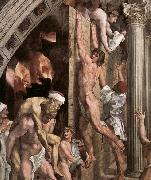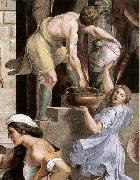
|
Raphael
|
|||
|
|
|||
| Italian High Renaissance Painter, 1483-1520 Raphael Sanzio, usually known by his first name alone (in Italian Raffaello) (April 6 or March 28, 1483 ?C April 6, 1520), was an Italian painter and architect of the High Renaissance, celebrated for the perfection and grace of his paintings and drawings. Together with Michelangelo and Leonardo da Vinci, he forms the traditional trinity of great masters of that period. Raphael was enormously productive, running an unusually large workshop, and, despite his early death at thirty-seven, a large body of his work remains, especially in the Vatican, whose frescoed Raphael Rooms were the central, and the largest, work of his career, although unfinished at his death. After his early years in Rome, much of his work was designed by him and executed largely by the workshop from his drawings, with considerable loss of quality. He was extremely influential in his lifetime, though outside Rome his work was mostly known from his collaborative printmaking. After his death, the influence of his great rival Michelangelo was more widespread until the 18th and 19th centuries, when Raphael's more serene and harmonious qualities were again regarded as the highest models. His career falls naturally into three phases and three styles, first described by Giorgio Vasari: his early years in Umbria, then a period of about four years (from 1504-1508) absorbing the artistic traditions of Florence, followed by his last hectic and triumphant twelve years in Rome, working for two Popes and their close associates. | |||
|
|
|||
|
The Fire in the Borgo Raphael39.jpg Painting ID:: 3320 |
Fresco The Vatican | ||
|
|
|||
|
RAFFAELLO Sanzio
|
|||
|
|
|||
| Italian High Renaissance Painter, 1483-1520 Italian painter and architect. As a member of Perugino's workshop, he established his mastery by 17 and began receiving important commissions. In 1504 he moved to Florence, where he executed many of his famous Madonnas; his unity of composition and suppression of inessentials is evident in The Madonna of the Goldfinch (c. 1506). Though influenced by Leonardo da Vinci's chiaroscuro and sfumato, his figure types were his own creation, with round, gentle faces that reveal human sentiments raised to a sublime serenity. In 1508 he was summoned to Rome to decorate a suite of papal chambers in the Vatican. The frescoes in the Stanza della Segnatura are probably his greatest work; the most famous, The School of Athens (1510 C 11), is a complex and magnificently ordered allegory of secular knowledge showing Greek philosophers in an architectural setting. The Madonnas he painted in Rome show him turning away from his earlier work's serenity to emphasize movement and grandeur, partly under Michelangelo's High Renaissance influence. The Sistine Madonna (1513) shows the richness of colour and new boldness of compositional invention typical of his Roman period. He became the most important portraitist in Rome, designed 10 large tapestries to hang in the Sistine Chapel, designed a church and a chapel, assumed the direction of work on St. Peter's Basilica at the death of Donato Bramante, | |||
|
|
|||
|
The Fire in the Borgo new21/RAFFAELLO Sanzio-368567.jpg Painting ID:: 63790 |
1514 Fresco Stanza dell'Incendio di Borgo, Palazzi Pontifici, Vatican The group in the left foreground, for example (made up of an old man on the shoulders of a young man, and a child), may be drawn from the episode of the Aeneid in which Aeneas escapes with his father, Anchises and his son, Ascanius. The nude descending from the wall at left recalls the heroic figures of Michelangelo.Artist:RAFFAELLO Sanzio Title: The Fire in the Borgo (detail) Painted in 1501-1550 , Italian - - painting : religious | ||
|
|
|||
|
RAFFAELLO Sanzio
|
|||
|
|
|||
| Italian High Renaissance Painter, 1483-1520 Italian painter and architect. As a member of Perugino's workshop, he established his mastery by 17 and began receiving important commissions. In 1504 he moved to Florence, where he executed many of his famous Madonnas; his unity of composition and suppression of inessentials is evident in The Madonna of the Goldfinch (c. 1506). Though influenced by Leonardo da Vinci's chiaroscuro and sfumato, his figure types were his own creation, with round, gentle faces that reveal human sentiments raised to a sublime serenity. In 1508 he was summoned to Rome to decorate a suite of papal chambers in the Vatican. The frescoes in the Stanza della Segnatura are probably his greatest work; the most famous, The School of Athens (1510 C 11), is a complex and magnificently ordered allegory of secular knowledge showing Greek philosophers in an architectural setting. The Madonnas he painted in Rome show him turning away from his earlier work's serenity to emphasize movement and grandeur, partly under Michelangelo's High Renaissance influence. The Sistine Madonna (1513) shows the richness of colour and new boldness of compositional invention typical of his Roman period. He became the most important portraitist in Rome, designed 10 large tapestries to hang in the Sistine Chapel, designed a church and a chapel, assumed the direction of work on St. Peter's Basilica at the death of Donato Bramante, | |||
|
|
|||
|
The Fire in the Borgo new21/RAFFAELLO Sanzio-236533.jpg Painting ID:: 63791 |
1514 Fresco Stanza dell'Incendio di Borgo, Palazzi Pontifici, Vatican The figures in the foreground are desperately trying to put out the fire.Artist:RAFFAELLO Sanzio Title: The Fire in the Borgo (detail) Painted in 1501-1550 , Italian - - painting : religious | ||
|
|
|||
|
Also Buy::. For Following Paintings / Artists / Products, Please Use Our Search Online: |










